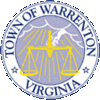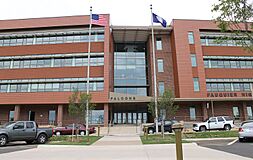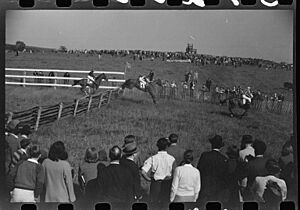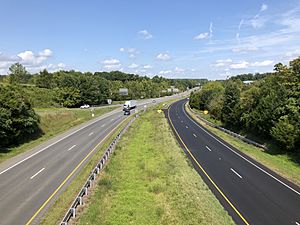Warrenton, Virginia facts for kids
Quick facts for kids
Warrenton, Virginia
|
||
|---|---|---|
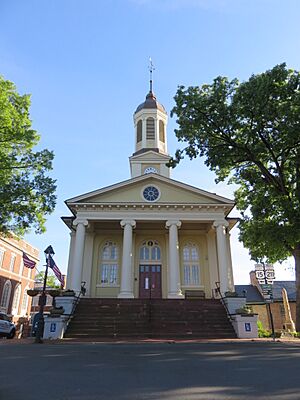
Courthouse Square
|
||
|
||
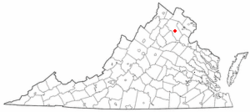
Location in Virginia
|
||
| Country | United States | |
| State | Virginia | |
| County | Fauquier | |
| Founded | 1810 | |
| Named for | Joseph Warren | |
| Government | ||
| • Type | Council-Manager | |
| Area | ||
| • Total | 4.38 sq mi (11.34 km2) | |
| • Land | 4.37 sq mi (11.33 km2) | |
| • Water | 0.01 sq mi (0.01 km2) | |
| Elevation | 643 ft (196 m) | |
| Population
(2020)
|
||
| • Total | 10,057 | |
| • Estimate
(2021)
|
10,109 | |
| • Density | 2,296.1/sq mi (885.01/km2) | |
| Time zone | UTC-5 (Eastern (EST)) | |
| • Summer (DST) | UTC-4 (EDT) | |
| ZIP codes |
20186-20188
|
|
| Area code(s) | 540, 703, 571 | |
| FIPS code | 51-83136 | |
| GNIS feature ID | 1500278 | |
Warrenton is a town in Fauquier County, Virginia, United States. It is the county seat. The population was 10,057 as of the 2020 census, an increase from 9,611 at the 2010 census and 6,670 at the 2000 census. The estimated population in July 2021 was 10,109. It is at the junction of U.S. Route 15, U.S. Route 17, U.S. Route 29, and U.S. Route 211. The town is in the Piedmont region of Virginia just east of the Blue Ridge Mountains. The well-known Airlie Conference Center is 3 miles (5 km) north of Warrenton, and the historic Vint Hill Farms military facility is 9 miles (14 km) east. Fauquier Hospital is located in the town. Surrounded by Virginia wine and horse country, Warrenton is a popular destination outside Washington, D.C.
Warrenton shares some services with the county, such as schools and the county landfill. The area was home to Bethel Military Academy.
Contents
History
The settlement which would grow into the town of Warrenton began as a crossroads at the junction of the Falmouth-Winchester and Alexandria-Culpeper roads, where a trading post called the Red Store was located. In the 1790s, a courthouse was built in the area, and the location was known as "Fauquier Courthouse".
The Town of Warrenton was incorporated on January 5, 1810, and named for General Joseph Warren, a Revolutionary War hero. Richard Henry Lee donated the land for the county seat. John S. Horner, Secretary of Wisconsin Territory and Acting Governor of Michigan Territory, was born in Warrenton. John Marshall, the fourth Chief Justice of the U.S. Supreme Court, was from Germantown, modern-day Midland, 10 miles (16 km) south of Warrenton.
Confederate Colonel John S. Mosby made raids in the town during the Civil War and later made his home and practiced law in Warrenton. The Warren Green Hotel building hosted many famous people, including the Marquis de Lafayette, James Monroe, Andrew Jackson, Henry Clay, President Theodore Roosevelt, and divorcée Wallis Simpson. Union General George B. McClellan bade farewell to his officers November 11, 1862, from the steps of the hotel. It now hosts some offices of the Fauquier County government.
In 1909, a fire destroyed almost half the structures in the town, and was halted with the use of dynamite to create a firebreak to stop the flames from spreading.
In 1951, the federal government established the Warrenton Training Center just outside Warrenton. The center is a secret Central Intelligence Agency communications facility, which also houses an underground relocation bunker containing communications infrastructure to support continuity of government in the event of a nuclear attack on Washington, DC.
A bypass route around the town was built in the early 1960s, which attracted restaurants, gas stations, and shopping centers, but also drew businesses away from the center of town.
The Warrenton Historic District was listed on the National Register of Historic Places in 1983. Other listings in or near Warrenton include Brentmoor, Dakota, Hopefield, Loretta, Monterosa, North Wales, The Oaks, the Old Fauquier County Jail, and Yorkshire House.
Geography
Warrenton is located in central Fauquier County at 38°43′06″N 77°47′50″W / 38.71833°N 77.79722°W (38.718307, -77.797085). U.S. Route 29 leads northeast 12 miles (19 km) to Gainesville and 47 miles (76 km) to Washington, D.C., and southwest 25 miles (40 km) to Culpeper. U.S. Route 15 follows US 29 out of town in both directions, but leads north-northeast 34 miles (55 km) to Leesburg. U.S. Route 17 leads northwest 42 miles (68 km) to Winchester and southeast 44 miles (71 km) to Fredericksburg, and U.S. Route 211 leads west 34 miles (55 km) to Skyline Drive in Shenandoah National Park.
According to the United States Census Bureau, Warrenton has a total area of 4.5 square miles (11.7 km2), of which 0.004 square miles (0.01 km2), or 0.13%, is water. The eastern, southern, and northern parts of the town drain east to Cedar Run, a tributary of the Occoquan River and part of the Potomac River watershed, while the western part of town drains south via Great Run to the Rappahannock River.
Education
Primary and secondary schools
Fauquier County Public Schools serves Warrenton. The elementary schools within the town serve Kindergarten to Fifth grades and consist of James G. Brumfield Elementary, Carson M. Bradley Elementary, and Peter. B. Smith Elementary.
The only public middle school that serves Warrenton is Taylor Middle School. Taylor Middle School serves grades six through eight. Warrenton Middle School was closed following the 2022–2023 school year and temporarily merged with Taylor Middle School during the construction of a new middle school also to be named Taylor Middle School.
The high school that serves Warrenton is Fauquier High School, which educates grades Nine through 12. The Fauquier County Public School system also operates an extremely small alternative learning school at Southwest Alternative School. This school serves both middle and high school students throughout the county, including Warrenton.
There are three private schools in the town of Warrenton: Highland School, St. John The Evangelist's Catholic School, and St. James' Episcopal School.
Colleges and universities
The Fauquier campus of Laurel Ridge Community College resides just south of the town limits.
In 2022, Hazel Hall, a science, engineering and health professions building, was opened and construction begun on a Center for Skilled Trades.
Public libraries

The Fauquier Public Library's Warrenton Library is located within the Warrenton Historic District. Despite being located within the town, the library is actually run by the county government's Library Board. Each public school also has an internal library that students can access. Additionally, public bookcases adorn the town, often on the property of private citizens, acting in a manner similar to Little Free Library
Arts and culture
Steeplechases have had a large impact on the culture within Fauquier County as well as the Town of Warrenton. This is largely due to the 1922 organization of the first Virginia Gold Cup race within the town. This event, along with the Maryland Hunt Cup, were two of the most prominent horse races at the time and remained prominent throughout the 20th century. Following the 1984 race, the event was moved to the nearby city, The Plains, where it has remained. The Virginia Gold Cup and International Gold Cup Race have drawn upwards of 50,000 attendees per year, assuring its cultural impact in the surrounding communities.
On the first Friday of each month between May and October, the Town of Warrenton hosts a themed street fair called "First Friday" within the Warrenton Historic District. Each month is typically themed to a different topic, affecting what local vendors and activities are available during the event.
The Town of Warrenton owns and operates four public parks and one recreation center.
Warrenton has several pieces of public art adorning the town. In 2001, watercolor painter Stewart Burgess White painted three murals on a single building depicting scenes from the American Civil War. Additionally, these murals included several hidden details such as faces of 19th century American leaders, references to the September 11 attacks, and the name of the painter's daughter. Artists Ross Trimmer and Michael Broth collaborated on a mural that emulates classic large-letter postcards. In 2021, a group of local National Honor Society students from Kettle Run High School painted a small mural on a neglected wall lining a parking lot.
Transportation
Warrenton is served by four U.S. Routes; U.S. Route 15, U.S. Route 17, U.S. Route 29 (which collectively form the Eastern Bypass) and U.S. Route 211. US 15 extends north and south, heading towards Leesburg in the north and Orange to the south. US 17 is oriented northwest to southeast, connecting to Winchester to the northwest and Fredericksburg to the southeast. US 29 is oriented northeast to southwest, reaching Washington, D.C. to the northeast and Charlottesville to the southwest. Finally, US 211 begins north of the downtown area and extends westward, passing through Luray and the Shenandoah Valley. All four highways originally passed directly through the center of town and now follow bypasses. However, downtown Warrenton is now served by U.S Route 15 Business, U.S Route 17 Business, U.S Route 29 Business and U.S Route 211 Business.
Virginia Regional Transit operates the Circuit Rider bus in Warrenton. Academy Bus operates a commuter bus from Warrenton to Washington, D.C. The Virginia Department of Rail and Public Transportation and Megabus operate a weekday commuter bus service called the Piedmont Express from Danville, V.A. to Washington, D.C. with a stop in Warrenton.
Notable people
- James DeRuyter Blackwell, Civil War-era poet and writer
- Steve Brodie, Major League Baseball player
- Edward Brooke, U.S. senator
- Anthony Cave Brown, Journalist and historian
- Jesse Brown, former U.S. Secretary of Veterans Affairs
- Matt Carson, Entrepreneur and author
- Samuel Chilton, 19th-century politician and lawyer
- Walter Chrysler, founder of the Chrysler Corporation
- Walter P. Chrysler Jr., art collector, museum benefactor, and Thoroughbred horse breeder
- Julia Ringwood Coston, 19th-century Afro-American publisher and magazine editor who founded the first magazine ever published for black women
- Mike Duvall, Major League Baseball player
- George B. Fitch, former mayor of Warrenton and co-founder of the Jamaican bobsled team
- Ella Fitzgerald, drag queen
- Benita Fitzgerald-Brown, Olympic athlete
- Grenville Gaines, mayor of Warrenton
- Craig Gilmore, winner, 2013 ESPN Tournament Challenge
- John S. Horner, acting governor of Michigan Territory
- Eppa Hunton, U.S. congressman and senator, brigadier general in the Confederate Army
- John C. Mackie, U.S. congressman
- Malcolm MacPherson, Newsweek correspondent and author
- Frances Harrison Marr (1835–1918), poet
- Charles Marshall, Confederate States Army colonel
- James K. Marshall, Confederate States Army colonel
- John Augustine Marshall, U.S. federal judge
- Thomas Love Moore, U.S. congressman and lawyer
- William Moore, blues musician
- John S. Mosby, Confederate cavalry battalion commander
- William H. F. Payne, Confederate States Army general
- Dorothy B. Porter, Bibliographer and curator, built the Moorland-Spingarn Research Center at Howard University
- Scott Shipp, superintendent of the Virginia Military Institute
- William "Extra Billy" Smith, congressman, twice governor of Virginia, and Confederate general
- Gwyn R. Tompkins, Thoroughbred horse racing trainer
- Septimus Tustin, clergyman
- Erica Wallach, American-German political activist and teacher
- Sarah White, singer-songwriter
- Charles S. Whitehouse, career Foreign Service officer, U.S. Ambassador to Laos and Thailand
- Bonnie Zacherle, illustrator and designer
Climate
The climate in this area is characterized by hot, humid summers and generally mild to cool winters. According to the Köppen Climate Classification system, Warrenton has a humid subtropical climate, abbreviated "Cfa" on climate maps.
Demographics
| Historical population | |||
|---|---|---|---|
| Census | Pop. | %± | |
| 1860 | 604 | — | |
| 1870 | 1,256 | 107.9% | |
| 1880 | 1,464 | 16.6% | |
| 1890 | 1,346 | −8.1% | |
| 1900 | 1,627 | 20.9% | |
| 1910 | 1,427 | −12.3% | |
| 1920 | 1,545 | 8.3% | |
| 1930 | 1,450 | −6.1% | |
| 1940 | 1,651 | 13.9% | |
| 1950 | 1,797 | 8.8% | |
| 1960 | 3,522 | 96.0% | |
| 1970 | 4,027 | 14.3% | |
| 1980 | 3,907 | −3.0% | |
| 1990 | 4,830 | 23.6% | |
| 2000 | 6,670 | 38.1% | |
| 2010 | 9,611 | 44.1% | |
| 2020 | 10,057 | 4.6% | |
| 2023 (est.) | 10,210 | 6.2% | |
| U.S. Decennial Census | |||
2020 census
As of the 2020 census, there were 10,057 individuals, 4,016 households, and 2,159 families living in the Town of Warrenton. Population density is 2,296.1 people per square mile (885.01/km2).
The racial makeup of the town is 77.0% White, 10.0% African American, 0.1% American Indian or Native Alaskan, 1.7% Asian, 0.0% Pacific Islander, 1.3% from other races, and 9.9% from two or more races. Hispanic or Latino of any race are 8.9% of the population.
Of the town's residents, 56.4% were female, 43.6% were male, 8.0% were under five years of age, 22.7% were under 18 years of age, and 16.7% were 65 years or older. The population pyramid (below) shows the percentage of individuals of each sex within each age group, with a rectangular shape. 6.9% were foreign born persons, 7.2% had a disability, 94.9% of adults were high school graduates, and 39.2% of adults had a bachelor's degree or graduate degree.
| Population pyramid 2021 | ||||
| % | Males | Age | Females | % |
| 0.84 | 85+ | 1.70 | ||
| 0.03 | 80–84 | 2.63 | ||
| 1.51 | 75–79 | 1.69 | ||
| 1.76 | 70–74 | 2.24 | ||
| 1.85 | 65–69 | 2.36 | ||
| 4.51 | 60–64 | 4.87 | ||
| 4.50 | 55–59 | 3.50 | ||
| 2.01 | 50–54 | 4.60 | ||
| 3.28 | 45–49 | 3.52 | ||
| 0.93 | 40–44 | 2.11 | ||
| 3.17 | 35–39 | 3.67 | ||
| 2.01 | 30–34 | 2.34 | ||
| 2.58 | 25–29 | 2.77 | ||
| 4.49 | 20–24 | 2.84 | ||
| 2.92 | 15–19 | 3.54 | ||
| 2.65 | 10–14 | 3.8 | ||
| 1.98 | 5–9 | 2.71 | ||
| 2.61 | 0–4 | 5.36 | ||
The 2020 census stated that the Town of Warrenton had 4,014 households, of which 2,159 were family households and 1,857 are non-family households, with an average of 2.43 residents per household. 92.0% of households had access to a computer and 87.1% had a broadband internet subscription. 11.1% of households spoke a language other than English at home. 63.1% of households own their housing units while 36.9% rent. The median household income was $78,275 while per capita income was $41,385. 6.2% of the town's residents live in poverty.
In Warrenton 74.7% of the population drives alone to work, 12.4% carpool, 3.3% walk to work, 0.0% via public transportation, 0.0% bicycle to work, 0.5% commute via other means, and 9.1% work from home. Additionally, the average commute time for Warrenton residents was 33.1 minutes.
See also
 In Spanish: Warrenton (Virginia) para niños
In Spanish: Warrenton (Virginia) para niños


